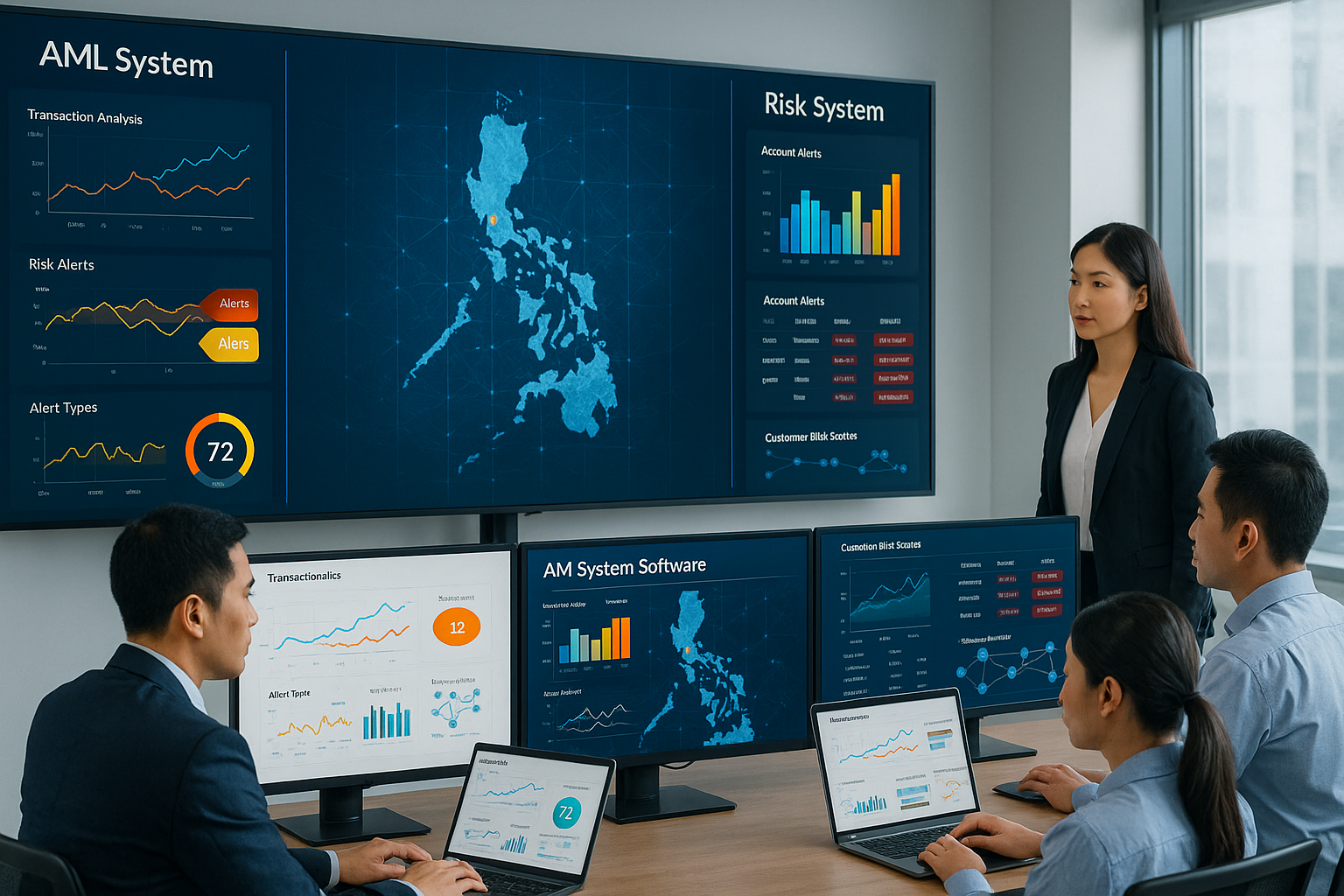How Transaction Monitoring Enhances Financial Security
.svg)
In the complex world of financial transactions, security is paramount. Financial institutions are constantly on the lookout for suspicious activities that could indicate financial crime.
One of the key tools in their arsenal is the transaction monitoring system. This technology tracks and analyzes financial transactions in real-time, flagging any activity that appears out of the ordinary.
But how exactly does it work? And how is it enhancing financial security?
This article will delve into the intricacies of transaction monitoring systems. We'll explore their functionality, the role of machine learning, and the importance of regulatory compliance.
We'll also look at the future of transaction monitoring, including the impact of emerging technologies and the importance of global collaboration.
Join us as we unravel the complexities of transaction monitoring and its critical role in enhancing financial security.
{{cta-first}}
The Critical Role of Transaction Monitoring in Financial Institutions
Transaction monitoring is indispensable for financial institutions. It acts as the first line of defense against financial crime. By diligently examining financial transactions, these systems help identify suspicious activities that could lead to fraud or money laundering.
Every transaction carries the potential risk of financial crime. With a robust monitoring system, financial institutions can detect unusual patterns early. This early detection plays a crucial role in preventing financial losses and maintaining the integrity of the financial system.
Regulatory bodies across the globe mandate the implementation of transaction monitoring systems. These requirements are part of a wider push to enhance financial security. Compliance ensures that institutions adhere to international standards, protecting both customers and the institution itself.
A key component of transaction monitoring is its ability to provide real-time analysis. This capability allows financial institutions to take immediate action when suspicious activity is detected. Quick response times are essential in mitigating the impact of financial crime.
Aside from preventing financial loss, transaction monitoring helps maintain trust with customers. Clients rely on these institutions to keep their funds secure, and effective monitoring reinforces this trust.
Finally, the insights gained from monitoring are invaluable. They guide financial institutions in refining their strategies and staying ahead of evolving financial crime tactics.

Understanding Transaction Monitoring Systems and Their Functionality
Transaction monitoring systems serve as vigilant guards within financial institutions. These systems track financial transactions in real-time, identifying patterns that might hint at financial crime. By scrutinizing every transaction, they help to catch suspicious activity before it escalates.
The functionality of these systems revolves around a combination of data analysis and alert mechanisms. As transactions occur, the system compares data against pre-defined criteria. If anomalies or potential risks are detected, the system generates alerts for further investigation.
A fundamental aspect of transaction monitoring is its adaptability. As criminals devise new tactics, systems must evolve to counteract them. This dynamic capability ensures that institutions remain resilient against emerging threats.
Transaction monitoring systems are equipped with sophisticated algorithms. These algorithms analyze diverse data points, enhancing precision in detecting financial crimes. From assessing transaction amounts to evaluating patterns across accounts, the system's scope is comprehensive.
An important feature is the ability to integrate data from various sources. By pooling information from internal and external databases, systems can build a more detailed picture of transactions. This integration amplifies the system's detection accuracy, reducing false positives.
Ultimately, transaction monitoring systems are crucial for compliance. They ensure institutions meet regulatory requirements by systematically identifying and reporting suspicious transactions. Compliance protects institutions from penalties and reinforces their financial integrity.
Rule-Based vs. Risk-Based Monitoring Approaches
Transaction monitoring employs two primary approaches: rule-based and risk-based. Each serves distinct purposes in detecting suspicious transactions.
Rule-based monitoring relies on predefined criteria. These rules act as filters, flagging transactions that deviate from normal patterns. For example, transactions exceeding certain amounts or occurring in high-risk regions might trigger alerts.
Conversely, risk-based monitoring tailors its scrutiny according to risk profiles. Here, customer behavior and transaction history determine the level of oversight. High-risk customers undergo more rigorous monitoring than their low-risk counterparts.
The strength of rule-based systems lies in their simplicity. They provide clear, straightforward guidelines for what constitutes suspicious activity. However, they can generate numerous false positives, overwhelming investigators.
Risk-based systems offer a more nuanced approach. By adjusting parameters based on risk, they target resources more efficiently. This precision aids in minimizing false positives, thus enhancing the overall effectiveness of the monitoring system.
Both approaches complement each other. Combining them creates a more comprehensive framework, accommodating the vast complexities of financial transactions.
The Integration of Machine Learning in Transaction Monitoring
Machine learning is transforming transaction monitoring systems. This technology enhances the system's ability to learn from historical data and evolve over time.
With machine learning, systems can recognize intricate patterns indicative of financial crime. Unlike static rules, machine learning algorithms dynamically adapt to new information. This flexibility allows for more accurate detection of unconventional suspicious activity.
The power of machine learning lies in its predictive capabilities. By analyzing vast amounts of data, it can forecast potential risks. This foresight enables financial institutions to preemptively address suspicious transactions before they materialize into a threat.
One significant advantage is the reduction of false positives. Machine learning fine-tunes the criteria for suspicious activities, aligning them more closely with genuine threats. This precision saves institutions time and resources, allowing them to focus on high-risk cases.
Moreover, machine learning enhances the system's ability to handle large datasets efficiently. As transaction volumes grow, this scalability is crucial to maintaining robust oversight without compromising performance.
In essence, the integration of machine learning into transaction monitoring systems offers a forward-thinking solution. It ensures that financial institutions remain agile in combating the ever-evolving landscape of financial crime.
Regulatory Requirements and Compliance in Transaction Monitoring
Regulatory compliance is vital in transaction monitoring for financial institutions. Global standards like those from the Financial Action Task Force (FATF) guide these efforts. Compliance ensures that institutions effectively monitor and report suspicious activities.
Failure to adhere to regulations can result in significant penalties. These include substantial fines and reputational damage. Compliance helps institutions avoid such consequences, maintaining their credibility and trust with customers.
Here are key regulatory requirements for transaction monitoring:
- Implement systems to detect and report suspicious activity.
- Conduct regular audits and assessments to ensure system effectiveness.
- Ensure staff training and awareness programs are up to date.
- Maintain comprehensive records of all transactions and investigations.
- Collaborate with regulatory bodies for continuous improvement.
Meeting these requirements necessitates constant system updates. Financial crime tactics evolve, and monitoring systems must adapt accordingly. Staying compliant means staying vigilant and proactive in system enhancements.
Ultimately, collaboration with regulators is essential. Institutions need to maintain open communication to align their practices with regulatory expectations. This collaboration ensures a cohesive approach to financial crime prevention.
The Role of Customer Due Diligence in Enhancing Monitoring Systems
Customer Due Diligence (CDD) forms the foundation of effective transaction monitoring. It involves verifying a customer's identity and understanding their financial activities.
CDD enriches monitoring systems by providing crucial customer insights. This data helps build accurate risk profiles. These profiles guide the level of scrutiny applied to customer transactions.
Enhanced Due Diligence (EDD) is vital for high-risk customers. It involves deeper analysis and more stringent monitoring. EDD supports the detection of suspicious activities among these customers.
The integration of CDD with monitoring systems improves overall accuracy. It refines the system's ability to distinguish between normal and suspicious activities. This synergy enhances financial security by aligning monitoring efforts with customer behavior.
Real-Time Monitoring and the Reduction of False Positives
Real-time monitoring is transformative in financial security. It offers immediate insights into financial transactions, enabling prompt action. This capability is critical for identifying suspicious activities as they occur.
One key advantage is reducing false positives. These are incorrect alerts of suspicious activity that can burden financial institutions. Real-time systems refine accuracy by analyzing patterns instantly.
By leveraging advanced algorithms, these systems filter out benign activities. This process minimizes distractions from genuine threats. As a result, investigators can focus resources on true risks, enhancing efficiency.
Immediate detection allows for swift responses to anomalies. This rapid action can prevent fraudulent transactions before completion. Thus, real-time monitoring directly contributes to financial safety.
Moreover, the integration of machine learning enhances this process. By learning from past incidents, systems continuously improve detection capabilities. This dynamic adaptation is crucial for addressing evolving financial crime tactics.
Case Management and Investigative Workflows in Financial Crime Detection
An effective case management system is central to financial crime investigations. It organizes and tracks all alerts generated by monitoring systems. This structure aids investigators in prioritizing and managing their workloads efficiently.
Case management involves documenting every step of an investigation. It ensures clarity and accountability throughout the process. This detailed record-keeping supports compliance with regulatory standards.
A streamlined workflow is essential for thorough investigations. It guides investigators through a standard process, reducing oversight. This consistency enhances the quality of financial crime detection efforts.
Collaboration is facilitated by comprehensive case management tools. Multiple team members can work on different aspects of a case simultaneously. This teamwork accelerates resolution and enriches the investigative process.
Finally, robust case management systems allow for comprehensive analysis and reporting. They enable investigators to draw insights from previous cases, improving future detection strategies. This iterative learning process is vital for continuous improvement in financial crime prevention.
The Future of Transaction Monitoring: AI, Blockchain, and Global Collaboration
Transaction monitoring is evolving with AI's rise. AI enhances pattern recognition and fraud detection. It anticipates threats by learning from large datasets.
Blockchain presents another frontier in security. Its transparency and immutability increase transaction traceability. This technology can revolutionize financial integrity.
Global collaboration among financial institutions is crucial. Sharing intelligence strengthens defenses against cross-border crimes. It fosters a unified approach to global financial security.
The integration of AI and blockchain requires careful implementation. Regulatory harmonization will be essential for cross-jurisdictional coherence. Effective governance will maximize their benefits in crime prevention.
Future developments must balance innovation and compliance. As technology advances, maintaining customer privacy remains paramount. Collaboration will be key to navigating these complex challenges.
Emerging Technologies and Their Impact on Financial Security
New technologies reshape financial security landscapes. Predictive analytics, for example, foresees potential threats. It uses data trends to guide preventive measures.
Data analytics is critical for understanding complex transactions. These insights allow for proactive risk management. Financial institutions can adapt quickly to emerging threats.
Moreover, automation reduces human error and inefficiencies. It ensures consistency in transaction monitoring. As a result, potential fraud becomes easier to spot.
Finally, these technologies require continual refinement. The financial crime landscape is always evolving. Staying ahead demands continuous technological advancement and innovation.
{{cta-whitepaper}}
Conclusion: The Continuous Evolution of Transaction Monitoring Systems
Transaction monitoring systems are not static; they constantly evolve. Financial institutions must adapt to changing crime tactics. Innovation and technology are vital in this dynamic landscape.
The integration of AI and blockchain signals future possibilities. These advancements offer robust solutions for complex challenges. Their strategic use can enhance both detection and prevention.
Moreover, global cooperation becomes increasingly important. Unified efforts can address cross-border financial crime effectively. Collaboration enriches the broader fight against illicit activities.
The future demands proactive and vigilant approaches. Financial institutions need to embrace change agilely. The commitment to evolution is key for safeguarding financial integrity.
Platforms like Tookitaki’s FinCense are leading this evolution by redefining how institutions approach transaction monitoring. As the Trust Layer for Financial Services, Tookitaki combines AI, collaborative intelligence, and federated learning to deliver accurate, real-time detection while reducing false positives. Its scenario-based approach ensures that institutions stay agile and compliant in a rapidly shifting threat landscape.
Experience the most intelligent AML and fraud prevention platform
Experience the most intelligent AML and fraud prevention platform
Experience the most intelligent AML and fraud prevention platform
Top AML Scenarios in ASEAN

The Role of AML Software in Compliance

The Role of AML Software in Compliance










